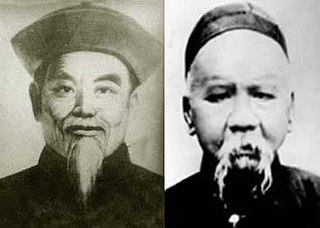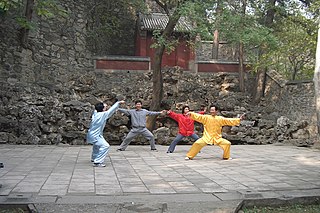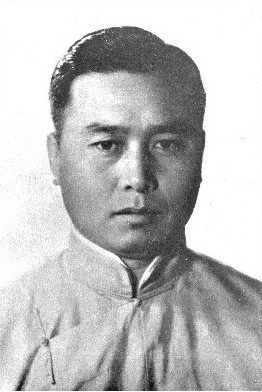| Part of a series on |
| Chinese martial arts (Wushu) |
|---|
 |
103-form Yang family tai chi, also called the Traditional Form (or, Long Form), is a prescribed sequence of moves used to practice Yang-style tai chi.
| Part of a series on |
| Chinese martial arts (Wushu) |
|---|
 |
103-form Yang family tai chi, also called the Traditional Form (or, Long Form), is a prescribed sequence of moves used to practice Yang-style tai chi.
The different slow motion solo form training sequences of tai chi are the best known manifestation of tai chi for the general public. In English, they are usually called the hand form or just the form; in Mandarin it is usually called quan (Chinese :拳; pinyin :quán; Wade–Giles :ch'üan2). They are usually performed slowly and are designed to string together an inventory of important techniques, and to promote relaxation, as well as other foundational principles.
This sequence of moves, when performed at its prescribed speed, usually takes approximately 25 to 30 minutes to complete.
The following is an English translation from Chinese of the form list used by the current Yang family teachers. Other Yang style schools may have significantly different enumeration schemes. The moves can also add up to 85, 88, 108, 113 [1] or 150 [2] depending on how they are counted. The book called Yang Shi Taijiquan ("Yang-style tai chi"), by Fu Zhongwen, breaks the form into each of its discrete movements.
The 103 postures of the Yang family style of tai chi are as follows:
| Chinese | Pinyin | English | |
|---|---|---|---|
| 第一段 | Section 1 | ||
| 1. | 预 备 | Yùbèi | Preparation Form |
| 2. | 起式 | Qǐ shì | Beginning |
| 3. | 揽雀尾 | Lǎn què wěi | Grasp the Bird's Tail |
| 4. | 单鞭 | Dān biān | Single Whip |
| 5. | 提手上势 | Tí shǒu shàng shì | Raise Hands and Step Forward |
| 6. | 白鹤亮翅 | Bái hè liàng chì | White Crane Spreads its Wings |
| 7. | 左搂膝拗步 | Zuǒ lōu xī ǎo bù | Left Brush Knee and Push |
| 8. | 手挥琵琶 | Shǒu huī pípá | Hand Strums the Lute |
| 9. | 左搂膝拗步 | Zuǒ lōu xī ǎo bù | Left Brush Knee and Push |
| 10. | 右搂膝拗步 | Yòu lōu xī ǎo bù | Right Brush Knee and Push |
| 11. | 左搂膝拗步 | Zuǒ lōu xī ǎo bù | Left Brush Knee and Push |
| 12. | 手挥琵琶 | Shǒu huī pípá | Hand Strums the Lute |
| 13. | 左搂膝拗步 | Zuǒ lōu xī ǎo bù | Left Brush Knee and Push |
| 14. | 进步搬拦捶 | Jìn bù bān lán chuí | Step Forward, Parry, Block, and Punch |
| 15. | 如封似闭 | Rú fēng shì bì | Apparent Close Up |
| 16. | 十字手 | Shí zì shǒu | Cross Hands |
| 第二段 | Section 2 | ||
| 17. | 抱虎归山 | Bào hǔ guī shān | Embrace the Tiger and Return to Mountain |
| 18. | 肘底捶 | Zhǒu dǐ chuí | Fist Under Elbow |
| 19. | 左倒撵猴 | Zuǒ dào niǎn hóu | Step Back and Repulse the Monkey, Left |
| 20. | 右倒撵猴 | Yòu dào niǎn hóu | Step Back and Repulse the Monkey, Right |
| 21. | 左倒撵猴 | Zuǒ dào niǎn hóu | Step Back and Repulse the Monkey, Left |
| 22. | 斜飞式 | Xié fēi shì | Diagonal Flying |
| 23. | 提手上势 | Tí shǒu shàng shì | Raise Hands and Step Forward |
| 24. | 白鹤亮翅 | Bái hè liàng chì | White Crane Spreads its Wings |
| 25. | 左搂膝拗步 | Zuǒ lōu xī ǎo bù | Left Brush Knee and Push |
| 26. | 海底针 | Hǎi dǐ zhēn | Needle at Sea Bottom |
| 27. | 扇通背 | Shàn tōng bèi | Fan Through the Back |
| 28. | 转身撇身捶 | Zhuǎn shēn piē shēn chuí | Turn Body and Chop with Fist |
| 29. | 进步搬拦捶 | Jìn bù bān lán chuí | Step Forward, Parry, Block, and Punch |
| 30. | 上步揽雀尾 | Shàng bù lǎn què wěi | Step Forward and Grasp the Bird's Tail |
| 31. | 单鞭 | Dān biān | Single Whip |
| 32. | 云手 | Yún shǒu | Cloud Hands (1) |
| 33. | 云手 | Yún shǒu | Cloud Hands (2) |
| 34. | 云手 | Yún shǒu | Cloud Hands (3) |
| 35. | 单鞭 | Dān biān | Single Whip |
| 36. | 高探马 | Gāo tàn mǎ | High Pat on Horse |
| 37. | 右分脚 | Yòu fēn jiǎo | Right Separation Kick |
| 38. | 左分脚 | Zuǒ fèn jiǎo | Left Separation Kick |
| 39. | 转身左蹬脚 | Zhuǎn shēn zuǒ dēng jiǎo | Turn Body and Left Heel Kick |
| 40. | 左搂膝拗步 | Zuǒ lōu xī ǎo bù | Left Brush Knee and Push |
| 41. | 右搂膝拗步 | Yòu lōu xī ǎo bù | Right Brush Knee and Push |
| 42. | 进步栽锤 | Jìn bù zāi chuí | Step Forward and Punch Down |
| 43. | 转身撇身锤 | Zhuǎn shēn piē shēn chuí | Turn Body and Chop with Fist |
| 44. | 进步搬拦锤 | Jìn bù bān lán chuí | Step Forward, Parry, Block, and Punch |
| 45. | 右蹬脚 | Yòu dēng jiǎo | Right Heel Kick |
| 46. | 左打虎式 | Zuǒ dǎ hǔ shì | Left Strike Tiger |
| 47. | 右打虎式 | Yòu dǎ hǔ shì | Right Strike Tiger |
| 48. | 回身右蹬脚 | Huí shēn yòu dēng jiǎo | Turn Body and Right Heel Kick |
| 49. | 双峰灌耳 | Shuāng fēng guàn ěr | Twin Fists Strike Opponents Ears |
| 50. | 左蹬脚 | Zuǒ dēng jiǎo | Left Heel Kick |
| 51. | 转身右蹬脚 | Zhuǎn shēn yòu dēng jiǎo | Turn Body and Right Heel Kick |
| 52. | 进步搬拦锤 | Jìn bù bān lán chuí | Step Forward, Parry, Block, and Punch |
| 53. | 如封似闭 | Rú fēng shì bì | Apparent Close Up |
| 54. | 十字手 | Shí zì shǒu | Cross Hands |
| 第三段 | Section 3 | ||
| 55. | 抱虎归山 | Bào hǔ guī shān | Embrace the Tiger and Return to Mountain |
| 56. | 斜单鞭 | Xié dān biān | Diagonal Single Whip |
| 57. | 右野马分鬃 | Yòu yě mǎ fēn zōng | Parting Wild Horse's Mane, Right |
| 58. | 左野马分鬃 | Zuǒ yě mǎ fēn zōng | Parting Wild Horse's Mane, Left |
| 59. | 右野马分鬃 | Yòu yě mǎ fēn zōng | Parting Wild Horse's Mane, Right |
| 60. | 揽雀尾 | Lǎn què wěi | Grasp the Bird's Tail |
| 61. | 单鞭 | Dān biān | Single Whip |
| 62. | 玉女穿梭 | Yù nǚ chuān suō | Fair Lady Works at Shuttles |
| 63. | 揽雀尾 | Lǎn què wěi | Grasp the Bird's Tail |
| 64. | 单鞭 | Dān biān | Single Whip |
| 65. | 云手 | Yún shǒu | Cloud Hands (1) |
| 66. | 云手 | Yún shǒu | Cloud Hands (2) |
| 67. | 云手 | Yún shǒu | Cloud Hands (3) |
| 68. | 单鞭 | Dān biān | Single Whip |
| 69. | 下势 | Xià shì | Snake Creeps Down |
| 70. | 左金鸡独立 | Zuǒ jīn jī dú lì | Golden Rooster Stands on One Leg, Left |
| 71. | 右金鸡独立 | Yòu jīn jī dú lì | Golden Rooster Stands on One Leg, Right |
| 72. | 左倒撵猴 | Zuǒ dào niǎn hóu | Step Back and Repulse the Monkey, Left |
| 73. | 右倒撵猴 | Yòu dào niǎn hóu | Step Back and Repulse the Monkey, Right |
| 74. | 左倒撵猴 | Zuǒ dào niǎn hóu | Step Back and Repulse the Monkey, Left |
| 75. | 斜飞势 | Xié fēi shì | Diagonal Flying |
| 76. | 提手上势 | Tí shǒu shàng shì | Raise Hands and Step Forward |
| 77. | 白鹤亮翅 | Bái hè liàng chì | White Crane Spreads its Wings |
| 78. | 左搂膝拗步 | Zuǒ lōu xī ǎo bù | Left Brush Knee and Push |
| 79. | 海底针 | Hǎi dǐ zhēn | Needle at Sea Bottom |
| 80. | 扇通背 | Shàn tōng bèi | Fan Through the Back |
| 81. | 转身白蛇吐信 | Zhuǎn shēn bái shé tǔ xìn | Turn Body and White Snake Spits out Tongue |
| 82. | 进步搬拦捶 | Jìn bù bān lán chuí | Step Forward, Parry, Block, and Punch |
| 83. | 上步揽雀尾 | Shàng bù lǎn què wěi | Step Forward and Grasp the Bird's Tail |
| 84. | 单鞭 | Dān biān | Single Whip |
| 85. | 云手 | Yún shǒu | Cloud Hands (1) |
| 86. | 云手 | Yún shǒu | Cloud Hands (2) |
| 87. | 云手 | Yún shǒu | Cloud Hands (3) |
| 88. | 单鞭 | Dān biān | Single Whip |
| 89. | 高探马穿掌 | Gāo tàn mǎ chuān zhǎng | High Pat On Horse with Palm Thrust |
| 90. | 十字腿 | Shí zì tuǐ | Cross Kick |
| 91. | 进步指裆锤 | Jìn bù zhǐ dāng chuí | Step Forward and Punch Groin |
| 92. | 上步揽雀尾 | Shàng bù lǎn què wěi | Step Forward and Grasp the Bird's Tail |
| 93. | 单鞭 | Dān biān | Single Whip |
| 94. | 下势 | Xià shì | Snake Creeps Down |
| 95. | 上步七星 | Shàng bù qī xīng | Step Forward Seven Stars |
| 96. | 退步跨虎 | Tuì bù kuà hǔ | Step Back and Ride the Tiger |
| 97. | 转身摆莲 | Zhuǎn shēn bǎi lián | Turn Body and Swing Over Lotus |
| 98. | 弯弓射虎 | Wān gōng shè hǔ | Bend the Bow and Shoot the Tiger |
| 99. | 进步搬拦捶 | Jìn bù bān lán chuí | Step Forward, Parry, Block, and Punch |
| 100. | 如封似闭 | Rú fēng shì bì | Apparent Close Up |
| 101. | 十字手 | Shí zì shǒu | Cross Hands |
| 102. | 收式 | Shōu shì | Closing |
| 103. | 还原 | Huán yuán | Return to Normal |

Neijia is the collective name for the internal Chinese martial arts. It relates to those martial arts occupied with spiritual, mental or qi-related aspects, as opposed to an "external" approach focused on physiological aspects. The distinction dates to the 17th century, but its modern application is due to publications by Sun Lutang, dating to the period of 1915 to 1928. Neijin is developed by using neigong or "internal changes", contrasted with waigong or "external exercises".

Tai chi is an ancient Chinese martial art. Initially developed for combat and self-defense, it has evolved into a sport and form of exercise. Tai chi is a gentle, low-impact form of exercise in which practitioners perform a series of deliberate, flowing motions while focusing on deep, slow breaths. Often referred to as "meditation in motion," tai chi aims to concentrate and balance the body's qi, providing benefits to mental and physical health.

Cheng Man-ch'ing or Zheng Manqing was a Chinese expert of tai chi, Chinese medicine, and the so-called three perfections: calligraphy, painting and poetry. He was born in Yongjia, Zhejiang Province, during the Qing dynasty. Cheng died March 26, 1975; his grave is near the city of Taipei in Taiwan.

Wu (Hao)-style tai chi is one of the five primary styles of tai chi. It was created in the mid-nineteenth century by Wu Yuxiang, a member of a wealthy and influential family in Yongnian, Hebei, China. Wu trained for approximately ten years with the founder of Yang-style tai chi, and then for over a month with a Chen-style master. Wu also obtained a manual on internal martial arts that formed the core of what are now known as the tai chi classics and include Wu's own writing on the subject. From these sources Wu and his family developed their own style, and may also have developed much of the cultural and intellectual foundation of tai chi as well.

Yang-style tai chi is one of the five primary families of tai chi. Including its variations, it is the most popular and widely practised style of tai chi in the world today. It is second in terms of seniority, after Chen-style tai chi.

The Chen-style tai chi is a Northern Chinese martial art and the original form of tai chi. Chen-style is characterized by silk reeling, alternating fast and slow motions, and bursts of power.
The 24-posture Simplified Form of tai chi, sometimes called the Beijing or Peking form for its place of origin, is a short version of tai chi composed of twenty-four unique movements.
108-Form Wu family tai chi, also known as Wu Jianquan-style tai chi, is a traditional form of tai chi that originated in China. It is named after its creator, Wu Jianquan, who developed this style of tai chi in the early 20th century.

Taoist tai chi is a form of tai chi which is taught in more than 25 countries by the non-profit International Taoist Tai Chi Society and associated national Taoist Tai Chi societies. It is a modified form of Yang-style tai chi developed by Taoist monk Moy Lin-shin in Toronto, Ontario, Canada. Moy incorporated principles of Liuhebafa and other internal arts to increase the health benefits of practising the form.

Yang Shaohou was a Chinese martial arts master who, along with Yang Chengfu, represents the third generation of Yang-style tai chi. Grandmaster of his generation and known for his compact "small frame" techniques, he was a ferocious fighter and a demanding teacher.

Wu Yinghua (1907–1996) was a famous Chinese teacher of Wu-style tai chi. She was born in Beijing and died in Shanghai. She was the eldest daughter of Wu Jianquan, the best known teacher of Wu-style tai chi. Her older brothers were Wu Gongyi and Wu Gongzao, also well-known tai chi practitioners.

Single Whip is a common posture found in most forms of tai chi. Typically at the end of the posture the left hand is in a palm outward push and the right hand held most commonly in the form of a hook or closed fist. Notable exceptions are the Single Whip forms found in Sun-style and Wu (Hao)-style, which finish with both hands open and palms outward.
The different slow-motion solo form training sequences of tai chi are the best-known manifestations of tai chi for the general public. In English, they are usually called the hand form or just the form. In Mandarin, it is usually called quan.

Chen Wangting (1580–1660), courtesy name Chen Zouting, was a Ming dynasty officer who may have founded Chen-style tai chi, one of the five major styles of the popular Chinese martial art. He reputedly devised his style of tai chi after his retirement following the fall of the Ming dynasty.

Yang Jun is a Wushu master who was born in Taiyuan, Shanxi, China in 1968 into the famous Yang family of martial artists. A son of Yang Daofang and a grandson of Yang Zhenduo, he is a direct descendant of Yang Chengfu and of Yang Luchan, the creator of Yang-style tai chi. Yang Jun is a sixth-generation descendant of the Yang Family of tai chi, and is the fifth lineage-holder of the style.

Dong Yingjie was a leading master of tai chi, and a top disciple of Yang Chengfu. Born in Ren County, Hebei, China, his given name was Wenke (文科). Famous in his time for defeating a foreign boxer in a public challenge match, he dedicated his life to the martial arts, training intensively in multiple styles, serving as chief assistant instructor for Yang Chengfu, and going on to found his own thriving tai chi legacy.

Yang Luchan, also known as Yang Fukui (1799–1872), was an influential Chinese practitioner and teacher of the internal style tai chi. He is known as the founder of Yang-style tai chi, the most popular and widely practised tai chi style in the world today.

Dong Huling was a master of tai chi, known for teaching Yang style and Dong style, and an early leader in the spread of tai chi worldwide. Born in Ren County, Hebei, China, his father Dong Yingjie was a top disciple of Yang Chengfu and famous for his fighting skills. Also highly skilled and creative himself, Dong Huling taught in mainland China, Hong Kong, Macau, Southeast Asia, North America, and Europe. He then emigrated to Hawaii, founding a school in Honolulu, continued teaching workshops around the world, and carried on the Dong family legacy.

Wu-style tai chi is one of the five main styles of tai chi. It is second in popularity after Yang-style, and the fourth-oldest of the five major tai chi styles. It was developed by Wu Quanyou and Wu Jianquan.